Published April 15, 2025. This post may contain affiliate links. Please read my disclosure policy.
This Salmon Piccata Recipe is a simple family dinner that pairs pan-seared salmon filets with a restaurant-quality white wine and caper sauce. As rich and elegant as the classic version made with chicken or veal, my variation offers a richer flavor profile that any salmon or Italian food fan will adore.
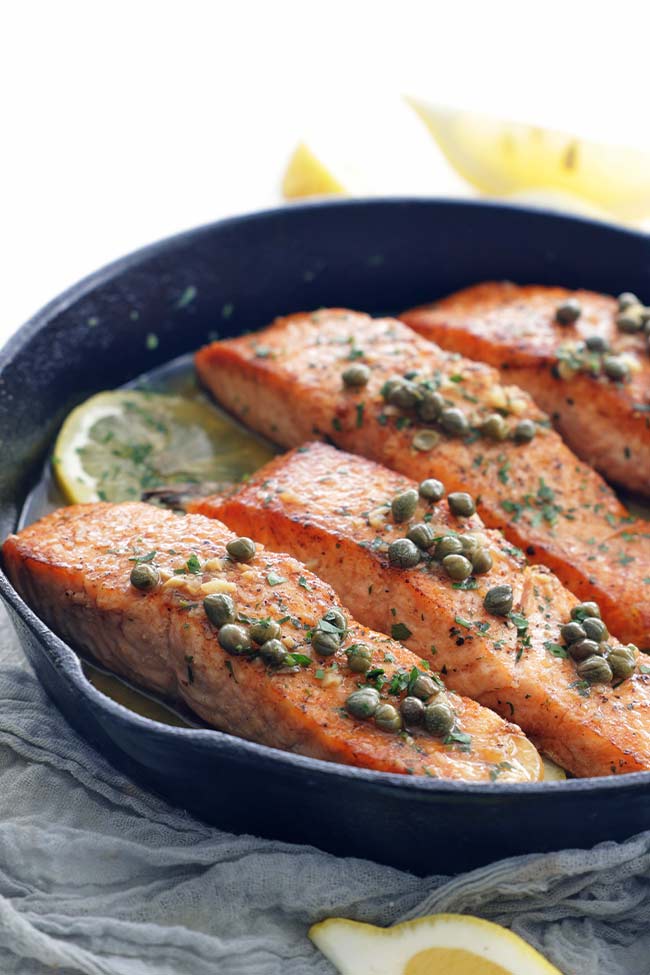
If I had to choose a fish to eat for dinner every day, salmon would be my number one choice. It’s a rich and fatty fish that you can sear, grill, broil, or smoke and serve with various sauces and sides. My salmon patties are one of my favorite simple salmon dinners, while this salmon piccata recipe is an easy and delicious way to upgrade this flexible protein.
Salmon Piccata Recipe
Piccata is an Italian dish that lightly coats sliced and pounded veal cutlets or chicken breasts in flour before being pan-fried until golden and crispy. They’re served with a simple pan sauce made with white wine, capers, butter, and lemon juice (similar to beurre blanc sauce) to give you a bright, buttery dinner with rice, greens, or potatoes. Swapping the veal or chicken with salmon puts a slightly lighter but just as delicious twist on this classic Italian meal.
Unlike my chicken piccata recipe, the salmon filets in this easy salmon piccata do not need to be sliced thin, tenderized, or coated in flour ahead of time. They’re lightly seasoned and pan-seared in a hot pan with olive oil and butter until they become flaky and slightly crispy outside. If you’re anything like me, you’ll be amazed at how this gourmet salmon recipe comes together in only one pan and in less than 30 minutes.
Ingredients and Substitutions
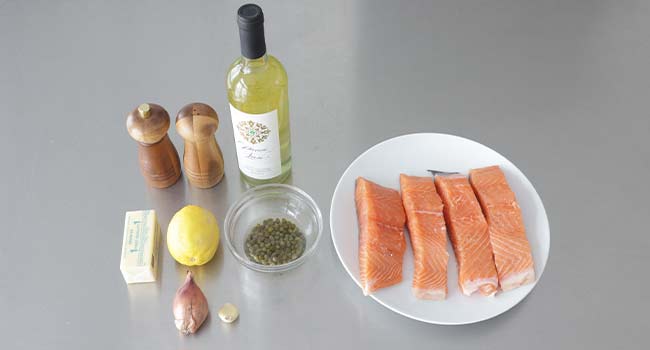
- Salmon – I like using skin-on salmon fillets best because the skin adds extra flavor and becomes deliciously crispy when pan-fried. You can use skinless salmon fillets if you aren’t as big of a fan of the skin as I am. I also try to use high-quality, fresh, wild-caught salmon for the best results, but frozen and thawed salmon works, too.
- Fat – Searing the salmon filets in both olive oil and butter not only prevents them from sticking but also encourages them to brown on the outside and fills them with buttery flavors. I always use unsalted butter in cooking to give me more control over the saltiness.
- Aromatics – I sauteed diced shallots and garlic cloves to give the piccata sauce a savory baseline of flavor.
- Wine — I recommend building the piccata sauce with a dry white wine you already enjoy. Chardonnay, Pinot Grigio, or Sauvignon Blanc all work well.
- Capers – A must in any piccata recipe. You could use green olives as a substitute, but the briny and salty flavors will be slightly toned down.
- Garnishes – Fresh parsley and lemon juice round out the sauce’s fresh flavors. A few fresh thyme sprigs would also be appropriate here.
How to Make Salmon Piccata
Season: To start, I pat the salmon filets dry with paper towels, then season both sides with salt and pepper.
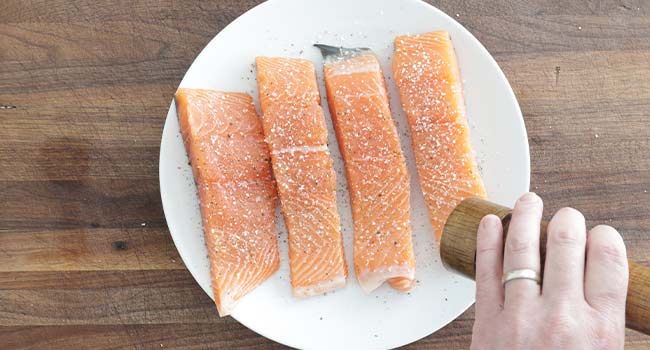
Pan-fry: After warming the oil in a large cast-iron skillet over medium-high heat, I add the seasoned salmon, skin side up. I drop in some butter to help brown the salmon, then let the filets pan-fry for 3 minutes. Next, I flip each filet, reduce the heat to medium, and cook for another 3 minutes.
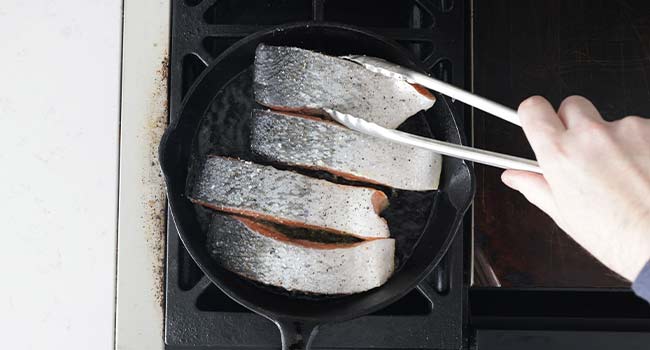
Rest: I transfer the seared salmon to a plate and let it cool. I drained all but 2 tablespoons of the remaining oil/butter in the pan.
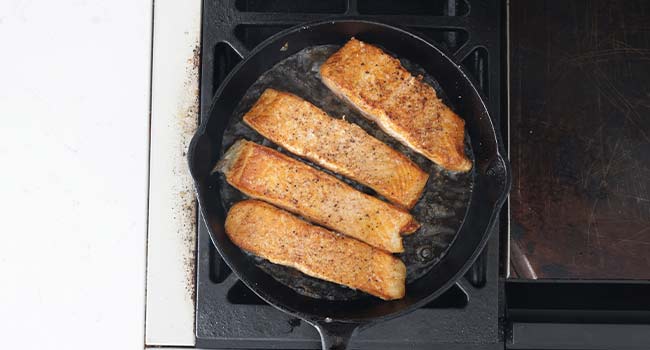
Make the sauce: I stir the shallots and garlic into the remaining fat in the empty pan, let them cook and become fragrant, and then deglaze the pan with the white wine. I add the capers and simmer the wine until only 1 to 2 tablespoons of liquid remain.
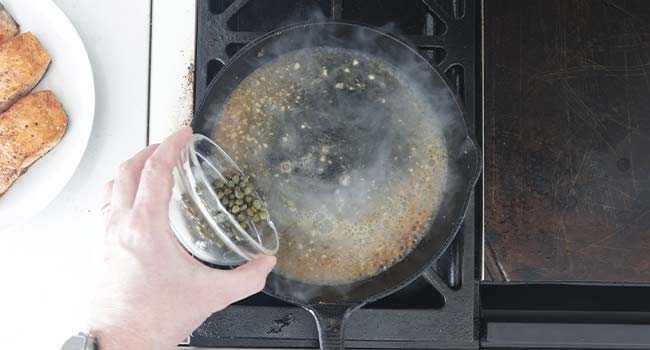
Emulsify: I add the parsley to the pan before taking it off the heat. I add the remaining butter and swirl the pan in a circular motion until the butter and white wine sauce have emulsified. I taste the sauce and adjust the flavors by adding more lemon juice, salt, and pepper.
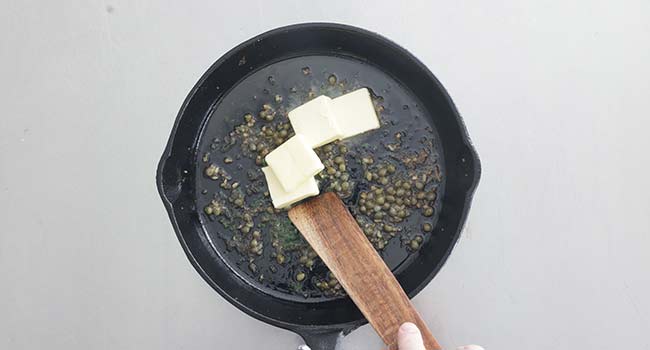
Serve: I nestle the salmon filets into the sauce and garnish them with the remaining parsley before serving.
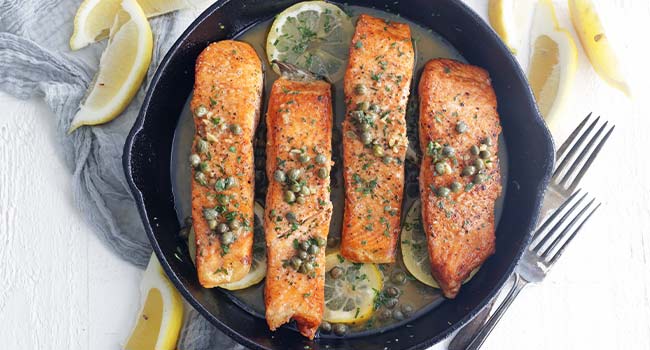

Chef Tips + Notes
Pan-sear the salmon until the edges are golden and slightly caramelized; the meat easily flakes when scraped with a fork, and the color has turned opaque. My 6-ounce skin-on salmon fillets only took 3 minutes per side to sear to perfection.
- Coat the salmon in flour: For extra crispy results, combine the salt and pepper with 1/4 cup of all-purpose flour. Coat each dried salmon fillet in the flour mixture before pan-searing as usual.
- For baked salmon piccata: For an even easier family dinner, arrange the salmon filets in a greased baking pan and bake in a 400ºF oven for 12 to 15 minutes or until flaky. Prepare the white wine sauce on the stove, then combine the baked salmon and sauce as usual before serving.
- Grill the salmon instead: If you’re making this on a particularly nice day, you can grill the salmon filets before tucking them back into the white wine sauce on the stove.
- Omit the wine: This will not be an actual piccata recipe without the white wine, but if you’d prefer to make the sauce without alcohol, you can replace it with an equal amount of chicken stock, vegetable stock, or fish stock. I recommend adding an extra splash of lemon juice at the end to replace the missing tangy flavors.
Serving Suggestions
I prefer to pair salmon piccata with a starchy side dish because they absorb the delicious sauce well. A side of rice pilaf instantly adds some elegance to the meal, while a bed of fluffy mashed potatoes is slightly more comforting. A side of cooked orzo, farro, or quinoa is a good option, too.
If you’re craving a lighter meal, you can also serve salmon piccata with a side of garlicky steamed spinach or sauteed green beans.
Last but not least, when I’m looking for an extra punch of flavor, I like to top the salmon with a few spoonfuls of Sicilian caponata. It instantly elevates the Italian flavors.
Make-Ahead and Storage
Make-Ahead: Pan-seared salmon is best when it’s eaten right away. However, if you want to get a head start on this recipe, prepare it up to 30 minutes in advance. Keep it warm in a covered skillet until serving.
How to Store: Transfer the leftover salmon and sauce to an airtight container and refrigerate for up to 5 days. The leftovers should also freeze well for up to 3 months. Thaw them in the fridge overnight before reheating.
How to Reheat: Add the salmon and sauce to a skillet and warm over low heat until heated. Add a splash of white wine or a knob of butter to the pan if the leftovers are a bit dry. You can also reheat the leftovers in the microwave for 1 to 2 minutes.
More Salmon Recipes

Salmon Piccata
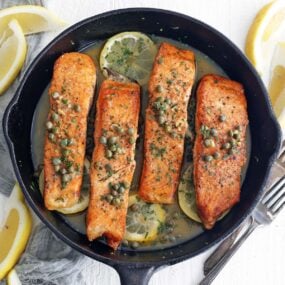
Ingredients
- 4 6- ounce sliced skin-on fresh salmon
- 3 tablespoons olive oil
- 8 tablespoons unsalted butter
- ½ peeled small diced shallot
- 1 finely minced garlic cloves
- ½ cup dry white wine
- 3 tablespoons capers
- 2 tablespoons minced freshly parsley
- Juice of ½ lemon
- coarse salt and freshly cracked pepper
Instructions
- Pat the salmon dry on both sides with paper towels, then season both sides with salt and pepper.
- Add the oil to a large cast-iron skillet and heat over medium-high heat until it smokes lightly.
- Place the salmon, skin side up, and add 1 tablespoon of butter to help brown it. Cook for 3 minutes, then flip it over, turn the heat down to medium, and cook for 3 more minutes.
- Remove the salmon and set it aside on a plate. Drain all but 2 tablespoons of the remaining oil/butter in the pan.
- Stir in the shallots and garlic, and cook for 30 to 45 seconds before deglazing with white wine and adding the capers. Cook until there are only 1 to 2 tablespoons of liquid remaining.
- Add 1 tablespoon of parsley and remove the pan from the heat. Stir in the remaining butter by moving the pan in a circular motion to swirl it in and emulsify it. Adjust the seasoning with lemon juice, salt, and pepper.
- Place the salmon back in the pan with the sauce, garnish with remaining parsley, and serve.

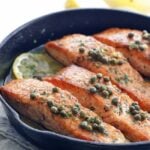
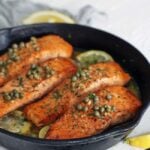
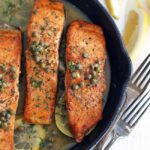
Buttery Salmon Piccata